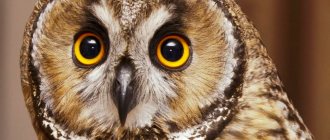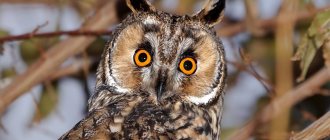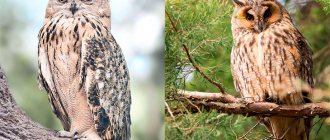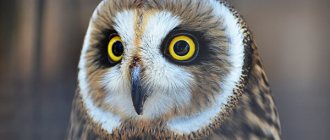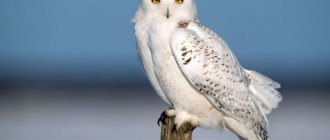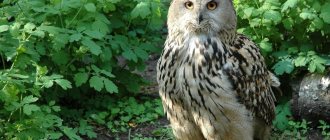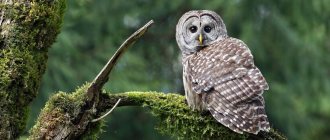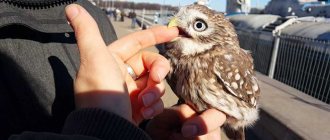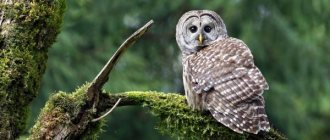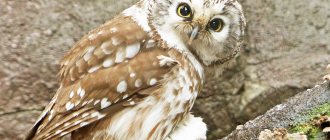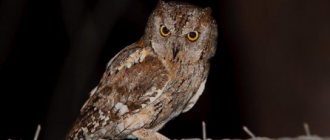True owls (Striginae)
Scops Owl
Scoops. Excellent camouflage on a tree, their dense build makes them indistinguishable among the trunks if the bird’s eyes are closed. Small species of owls are widespread throughout Europe, Asia, and America. Distinctive features are expressed by an incomplete facial disc, high feathery “ears,” and fingers covered in hard bristles.
In Russia, the scops owl is well known, a medium-sized bird, 20-25 cm long, with gray-brown plumage with white and black splashes. The bird's melodic, periodically sounding "sleep-oo-oo" voice gave the name to the species. They lead a migratory or sedentary lifestyle, depending on their habitat. Migratory cutworms winter in African savannas.
Listen to the voice of Scops Owl
Small species of owls are active in the early morning
Tawny Owl
Large nocturnal hunters do not miss the opportunity to become active in search of prey already at twilight. In the ancient Russian language birds were mentioned as insatiable predators. The flight is completely silent, thanks to the special structure of the feather. The birds are often called simply forest owls; their hoots are often confused with the calls of an eagle owl.
Listen to the cries of a tawny owl
It is very rare to see a tawny owl during the day, unless small birds disturb the owl's rest and force it to fly away from their crackling and cries.
In the forests of northern latitudes there is a great gray owl with a large head and a pronounced facial disc. The dark rings around the small yellow eyes are called the bird's "spectacles." Gray-brown plumage, a white collar on the neck, a dark spot under the beak, similar to a beard, give the bird an aristocratic appearance.
Eagle owls
Large representatives of the owl family are distinguished by their barrel-shaped body shape, loose plumage of ocher shades, and tufts of ear feathers. The body length is 36 – 75 cm. Hares, young roe deer, and pheasants become prey. Excellent vision and hearing help in hunting.
They adapt to different biotopes with a good food supply, secluded nesting places, and sometimes settle within the city. Eagle owls are characterized by a sedentary life. They hold the record for longevity in their family.
19 species of eagle owls differ in their habitat, feeding habits, plumage shades, body weight, and dimensions.
Eagle owls are very secretive, so they are more often heard than seen
Snowy owl (white)
Unlike many members of the family, the bird’s camouflage plumage is white with dark streaks, as the predator lives in snow-white tundra expanses. Owls are medium-sized, bright yellow eyes, black beak.
Species of white owls are included in the Red Book. In search of food, birds migrate, sticking to open areas. The birds hunt in the early morning and at dusk; the diet is dominated by lemmings, but the owl can cope with a hare, partridge, and feasts on fish. The snowy owl catches up with its prey, swallows small animals whole, and drags large ones into the shelter to cut up the carcasses.
The white polar owl is considered one of the largest species of owls
Neotropical owls
They live on the American continents. The birds are medium in size, body length is 45 cm. They inhabit mangrove forests, savannas, coffee plantations, near fresh water sources. They prefer low-lying places.
Nootropic spectacled owls are named because of the white eyebrows and stripes separating the eyes and cheeks, against a dark background of plumage. The contrasting combination creates a semblance of glasses. Round head without protruding ear feathers.
The predominant color is brown in different shades, the belly is dirty yellow. On the neck there is a whitish half-collar with black spots on the chin. Not only small rodents become prey, but also animals whose mass exceeds the weight of the feathered hunter - opossums, skunks.
Barn owl
Owl species names include the barn owl genus, which is characterized by a heart-shaped facial disc. The body length is 35-40 cm. Typical features are the reddish color of the plumage with streaks, asymmetrical arrangement of the ear holes.
So, one can be at the level of the forehead, the second - at the level of the nostrils. Birds have acute hearing, significantly exceeding that of cats. Barn owls live on many continents except Antarctica.
Fish owls
They live near rivers, where they feed on their main prey – caught fish, the weight of which is often comparable to a bird of prey. Owls catch catfish, salmon, burbot, pike, and trout. There are small sharp spines on the bird's paws to hold slippery fish. Predators hunt in the evening and at night, looking for prey from branches hanging over the water.
Rare species of owls are on the verge of extinction. Deforestation and coastal development deprive birds of their usual habitats. The habitat includes the territories of Primorye, Amur region, river banks in Manchuria, Japan.
Fish owls
They represent a species of large birds, the body length of which is up to 60-70 cm, the weight reaches 4 kg. Impressive representatives are characterized by a massive physique, long wings, and large feathered “ears.” The plumage is gray-brown, with dark streaks.
In Russia, birds can be found on the Kuril Islands and Sakhalin. The floodplains of rivers rich in fish are favorite places for bird hunters. In winter, they feed near frost-free areas. The species of owls in the photographs taken on bodies of water are most often represented by fish eagle owls.
Fish owls have serrations on their claws, which allows them to hold the fish tightly
White-faced owls
Inhabitants of African countries, Congo, Ethiopia, Cameroon - in the territory from the equator to the Sahara Desert. The light facial plumage against the background of the gray protective body color gave the name to the bird genus. Inhabits acacia groves, shrub savannas, where it finds food in the form of a variety of insects, small rodents, reptiles, and small birds. Hunts from ambush.
White-faced noctuids are called transformers for their ability to significantly increase and decrease body size. The appearance of the owl changes depending on the size of the enemy. The fighting position in front of a small animal is expressed in a swollen state with outstretched wings. In front of a large predator, the owl shrinks, as if curling into its wings, closes its eyes - it becomes indistinguishable among the branches, forming something like a twig.
Owls see only what is in front of their eyes; their eyes cannot move in their sockets, but this is compensated by the mobility of their heads.
Cuban armyworm
A small bird endemic to the island of Cuba. Body length approximately 22 cm, small head, long unfeathered legs. Favorite habitats are rocky mountains and rocky niches. Owls' nests are located in tree hollows and cave crevices. It is active at night and hunts small birds and insects.
Western armyworm
The bird lives in coniferous and mixed forests. The body length is only 15 cm, the weight of an adult bird is no more than 65 g. The protective plumage is gray-brown tones with many contrasting streaks. A distinctive feature is manifested in the fiery red areas of color on the wings and facial disc. Leads a migratory life. Winters in southern Texas and California.
Great Horned Owl
Lives on the plains, in the forests of Mexico and Costa Rica. The bird received its name because of its light eyebrows, stretching to high ear tufts of tufts of white feathers, the general line of which resembles “horns.”
The color of the plumage is gray-brown with contrasting spots and stripes characteristic of all owls. The feet are covered with feathers down to the base of the toes. The birds' voices are similar to croaking, screams are heard at intervals of 5-10 seconds.
The bird's anxious state is expressed by stretching its body, which makes the tawny owl look like a thick branch. The food supply of birds consists of various beetles, caterpillars, and small vertebrate organisms.
Perfect Verbs
Perfective verbs in the indefinite form answer the question: what to do?
Perfective verbs have two tense forms:
- past tense;
- future simple tense.
In any tense form they are called:
- an action that is limited by some limit;
- result, completeness of an action or a separate stage.
Examples of perfect verbs:
- What did you do? sat down - past tense, the action was completed and was done once, that is, not repeated;
- what will they do? talk - future simple tense, the action will be done and will not be repeated.
- what to do? close, pay, perform;
- what to do? identify, answer, simplify.
Perfective verbs can also denote actions that have already begun or are about to begin: I have spoken, I will speak.
